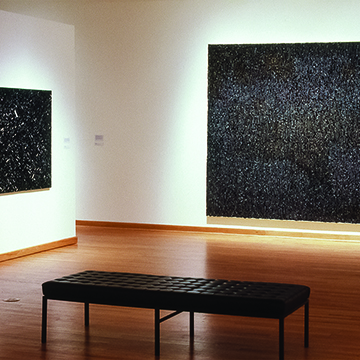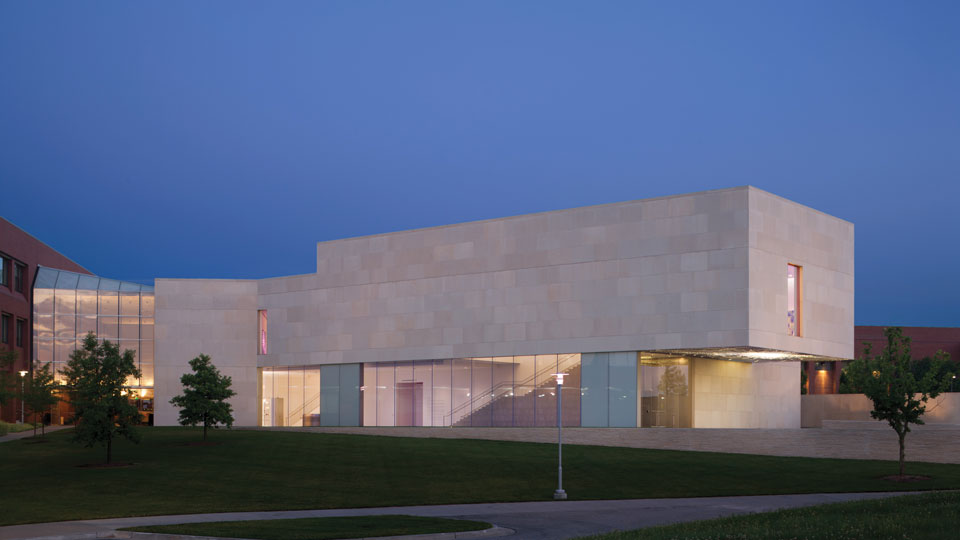Essential Gestures
Udomsak Krisanamis · Jonathan Lasker · Suzanne McClelland · James Nares · Dona Nelson
The five painters included in Essential Gestures rely on brushstrokes, marks or gestures to conceptualize and structure their works. While in some manner all five artists in this exhibition reference some aspect of abstract expressionism, their concerns vary considerably from their historic predecessors and from one another. This is the third exhibition at the JCCC Gallery of Art to explore contemporary directions in abstraction. In 1996, Getting Physical highlighted artists utilizing alternative materials and procedures, ranging from crushed velvet to recycled 35mm film and plastic gems. Most recently, The Point of Departure presented the work of Moira Dryer and Jessica Stockholder.
To construct his paintings, Udomsak Krisanamis engages in the obsessive process of pasting hundreds of tiny strips of newsprint to canvas. He then blackens out all text with a felt-tip pen – except, that is, for the “holes” found within letters or numbers, such as “O’s,” “P’s,” or zeroes. This exercise in precision results in a compelling sense of the infinite and produces a dark, sparking surface that suggests a night sky or a teeming city, while remaining adamantly abstract. Born in Bangkok, Thailand, in 1966, Krisanamis attended Chulalongkorn University, Bangkok, and earned a BFA in 1989. He came to the United States in 1991 and graduated with an MFA from the School of the Art Institute of Chicago in 1993.
Jonathan Lasker, a New York-based artist now in his early 30s, quickly makes his paintings’ presence known. A coldly bright background color, rows of nervous squiggles or patterns that veer from geometry to chaos, a surface disrupted by erratically placed passages of thick paint – everything in the paintings jostles with graphic tension, in colors that clash acidly against each other. Improbably, all of Lasker’s paintings since the mid-‘80s – with their meandering, seemingly improvised lines and heavy impasto that generally indicate spontaneous gestures – have been painstakingly copied from small studies. As Lasker explains, “I would draw them out free hand and then carefully trace (over) them. I was editing my own subconscious ... rendering it in such a manner that it became very clean and orderly.” His heavy impasto marks are indeed brushstrokes – only instead of the rapid gesture usually associated with a brushstroke, Lasker’s unwieldy, paste-like forms have been created in a kind of slow motion. Born in Jersey City, New Jersey, in 1948, Lasker attended the School of Visual Arts in New York City as well as the California Institute of the Arts in Valencia, California. Lasker lives and works in New York.
Language is a key element in Suzanne McClelland’s work: words – or bits of them – flow across her canvasses, swarming, drifting, repeating incessantly, changing in scale or appearing in reverse. Often spelled phonetically, they seem to disappear into or surface from globs of transparent acrylic and lyrically sprayed enamel paint. In its scattershot way, McClelland’s calligraphy eschews specific meaning, morphing instead into near-abstraction – an evocation, really, of the kind of utterance that forms on the tip of the tongue or in the back of the throat before being consciously articulated. McClelland was born in 1959 in Jacksonville, Florida, and received an MFA from the School of Visual Arts in New York.
James Nares’ work is elegantly spare and sensuous, with movements of the brush composing each painting. His trademark “gestures” recall a wealth of influences, from surrealism to Muybridge’s motion studies, and from oriental calligraphy to poetic traceries. Nares’ paintings speak to contemporary abstraction’s continuing fascination with the isolation and depersonalization of the autographic gesture. His strokes twist and turn, furl and unfurl their way across canvases tinted by wiped-out previous attempts, creating serpentine incidents of suspended liquidity and gesture. Nares was born in 1953 in England and attended Falmouth Art School and Chelsea Art School. He has been living in New York since 1974 where he has worked in painting, sculpture, music, photography, and film.
Since beginning her career in the early 1970s, Nebraska native Dona Nelson has sifted freely between abstraction and figuration. While creating gridded and architectural pieces, she began to make spontaneous compositions by pouring enamel onto canvas. In Nelson’s Plume, flowing enamel careens across the surface, looking like raw egg white and transforming a randomly arranged group of discs into a galaxy of flirtatious suns. The motion of the paint is not unlike that of a vintage lava lamp. “I was formed by ‘50s popular culture,” she notes. “I’ve never been a modernist.” Nelson was born in 1947 in Grand Island, Nebraska. After receiving her BFA from Ohio State University in 1968, she moved to New York and enrolled in the Whitney Studio Program.
The accompanying gallery guide features an essay, “Essential Gestures and Fundamental Signs,” by Saul Ostrow, artist, critic, curator and art editor of BOMB Magazine, New York.





